*This post may contain affiliate links. Read more »
Picture this: a warm, golden disc of freshly baked kuboos, still steaming from the oven, waiting to be torn apart and savored.
Making pita bread at home might seem like a daunting task, but trust me - it's wayyyyyyy easier than you think. With just a few simple ingredients that you probably already have in your pantry, you can have fresh, homemade pita bread that rivals anything you'll find in a store. Not to mention, the satisfaction that comes from creating something from scratch is unbeatable. The aroma that fills your kitchen as the bread bakes is pure heaven.


Enter your email & I'll send it to your inbox. Plus, get great new recipes from me every week!
By submitting this form, you consent to receive emails from Cinnamon Snail.
Its fluffy texture makes it the perfect vehicle for hummus, my vegan shawarma, kofta with tzatziki, Turkish shakshuka, or my easy-as-heck two-ingredient vegan labneh, or any other delicious Mediterranean dip.
So roll up your sleeves, dust off your apron, and let's start making some perfect fluffy kuboos.
Jump to:
🥰Why you'll adore this kuboos recipe
While it's certainly convenient to pick up a pack of nothing-special-about-it pre-made (read: OLD) pita bread at the grocery store, there's something special about making it yourself at home.
✊Unmatched Flavor and Texture: When you make your own kuboos, you have the opportunity to add delicious, aromatic additions to the dough (see my variations section in this post for some ideas).
🎉An actually fun project: It's a chance to learn a new skill and spend time in the kitchen creating something delicious. Plus, the aroma of fresh bread baking is intoxicating and can make your home feel warm and inviting!
7️⃣Only uses 7 ingredients that you probably have on hand! It's like that movie with Brad Pitt (Seven), except it's bread, and basically it's not that much like the movie with Brad Pitt at all... The only thing with fewer ingredients in the universe (maybe) is my Lebanese tarator recipe!
🌿Plant-based and natural: Free of animal products, cholesterol, and wacky dough conditioners, and artificial ingredients that store-bought pita often have. Kick that to the curb!


🤘Learn to make killer vegan Middle Eastern food
This guide to my most popular plant-based Middle Eastern recipes is 100% FREE, & you'll love the actual heck out of it 🥰
🌾 Kuboos ingredients
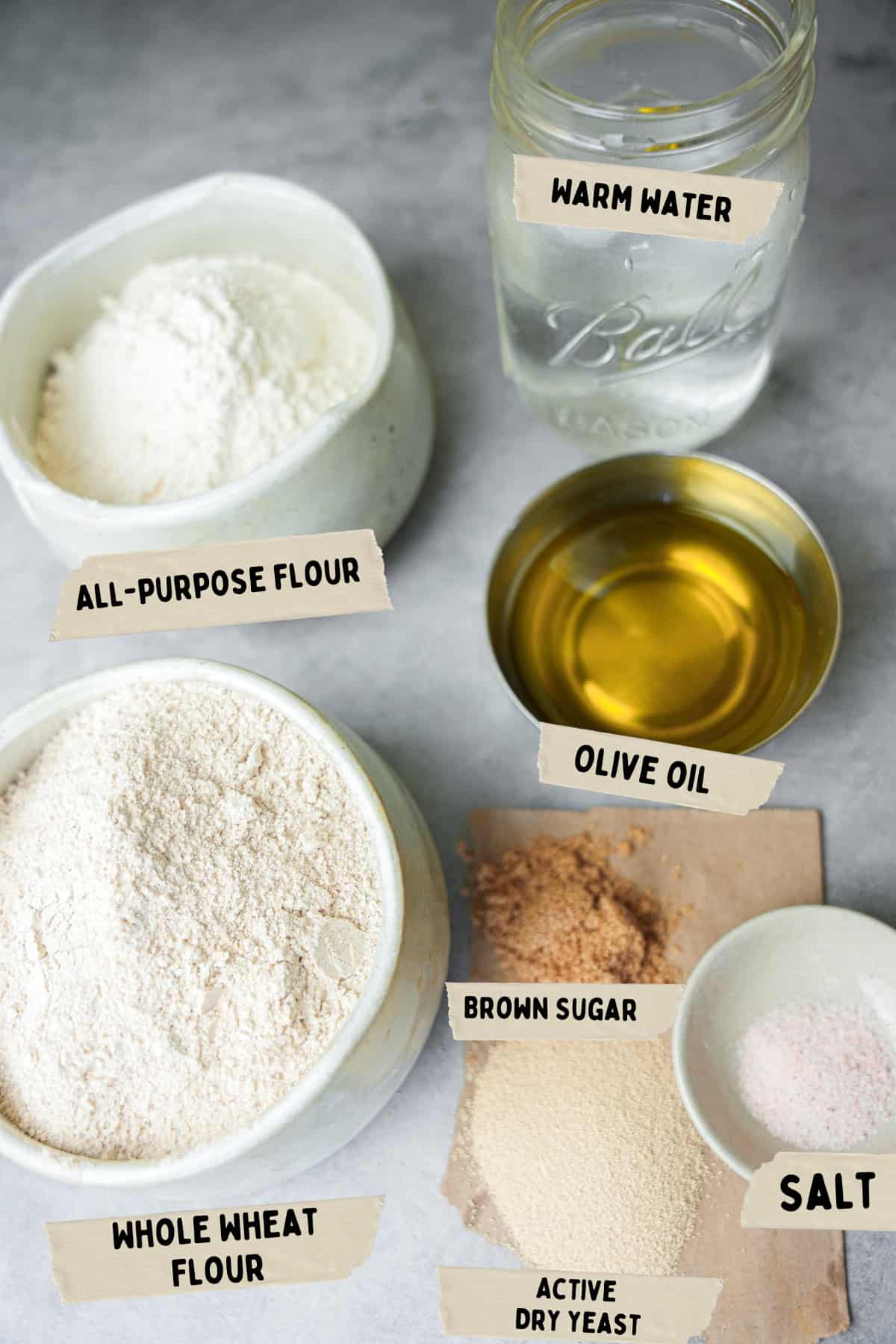
Active dry yeast
Active dry yeast is used to help the dough rise and create fluffy, delicious pita bread. If you're using instant yeast, you can use the same amount as called for in the recipe, but you don't need to activate it in water first. Simply mix it in with the dry ingredients and continue with the recipe as written. If using fresh yeast in place of active yeast, you’ll need to use double the amount of yeast, and dissolve it in water before adding to the dough. Keep in mind that the rising time may be slightly different depending on the type of yeast you use and the temperature, so keep an eye on the dough as it doubles in size.
Whole wheat flour
The use of whole wheat flour in this recipe for kuboos, is made by grinding the entire wheat kernel, including the bran and germ. This adds a unique flavor and texture that's authentic to traditional Lebanese pita bread. In addition to its distinct taste, whole wheat flour is a healthier alternative to white flour, providing more fiber, protein, and nutrients that contribute to the overall nutritional value of the dish.
Olive oil
When selecting olive oil for this recipe for kuboos, it's important to choose a high-quality oil that will add flavor and richness to the bread. Look for extra-virgin olive oil, which is made from the first cold pressing of the olives and has a fruity, aromatic flavor. Also, choose an olive oil with a low acidity level, as this indicates a higher quality oil.
Sugar
Cane sugar activates the yeast and adds a subtle sweetness to the bread. You can substitute brown sugar, coconut sugar, or palm sugar (which is also amzaing for making things like klepon and bubur sumsum) if you prefer a darker, more complex taste. Simply swap out an equal amount of one of these dry granulated sweeteners in place of the cane sugar.

🥟Blooming the yeast for kuboos bread making
Activating yeast, also known as proofing or blooming, is a crucial step in making kuboos (pita bread) and almost all other yeast-risen dough recipes. It involves mixing yeast with warm water and a sweetener, such as sugar, to create an ideal environment for the yeast to come to life and start fermenting. This process is important because it helps the dough rise and gives the bread its desired texture and flavor. It’s also a great way to determine if your yeast is no longer active, so that you can chuck the batch and start over before you waste costly ingredients and time on a dead batch of yeast.
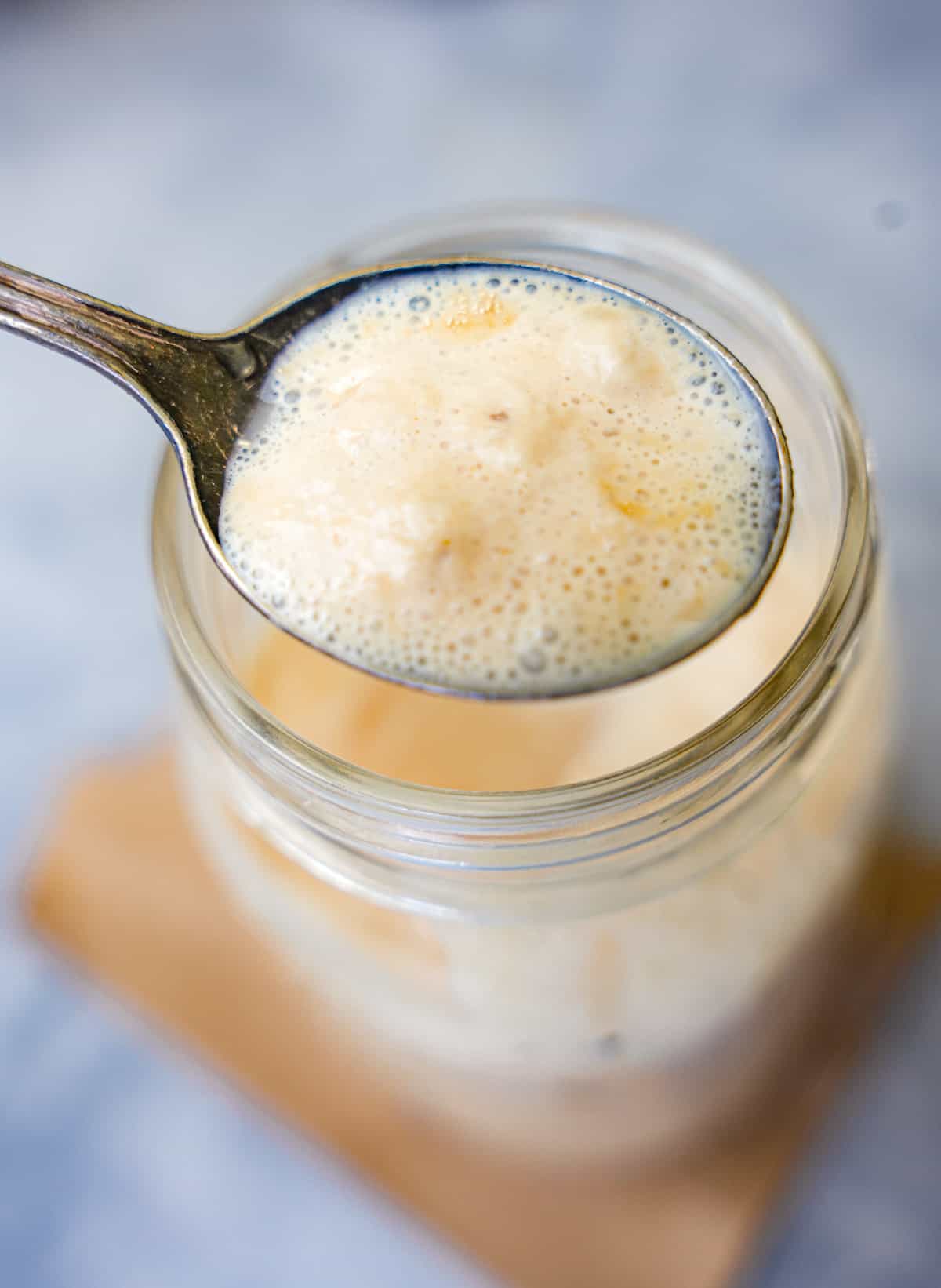
The temperature of the water used to activate the yeast is critical. Water that is too cold may not activate the yeast fully, resulting in a slow rise or dough that fails to rise at all. On the other hand, water that is too hot can kill the yeast, rendering it ineffective in leavening the dough. That's why it's important to use water within the optimal temperature range of 105°F to 115°F (40°C to 46°C) for best results. If you don't have a thermometer, it should feel like warm (not hot) bath water.
During the activation process, the yeast consumes the sugar in the water and produces carbon dioxide gas as a byproduct. The carbon dioxide gas gets trapped in the dough, causing it to expand and rise. This creates the characteristic airy and light texture of kuboos or pita bread, with its distinct pockets that can be filled with delicious ingredients.
The proofing step also helps to develop the flavor of the bread. As the yeast ferments, it produces various compounds that contribute to freshly baked bread's complex and delicious taste. This is why properly activating the yeast is crucial for achieving the desired taste and texture in kuboos.
In addition to using the correct water temperature, it's also important to let the yeast mixture sit undisturbed for a few minutes during proofing. This allows the yeast to fully activate and ferment before mixing it with other ingredients.
This pre-ferment stage helps the yeast become strong before it is mixed with the other ingredients like salt, which may slow the fermentation process. I use a similar process in my Amritsari Kulcha recipe, and my apple fritters too!
📖 How to make kuboos bread
Here is a visual guide to making perfect kuboos! Or you can follow along with the easy-to-print recipe card towards the bottom of this page.
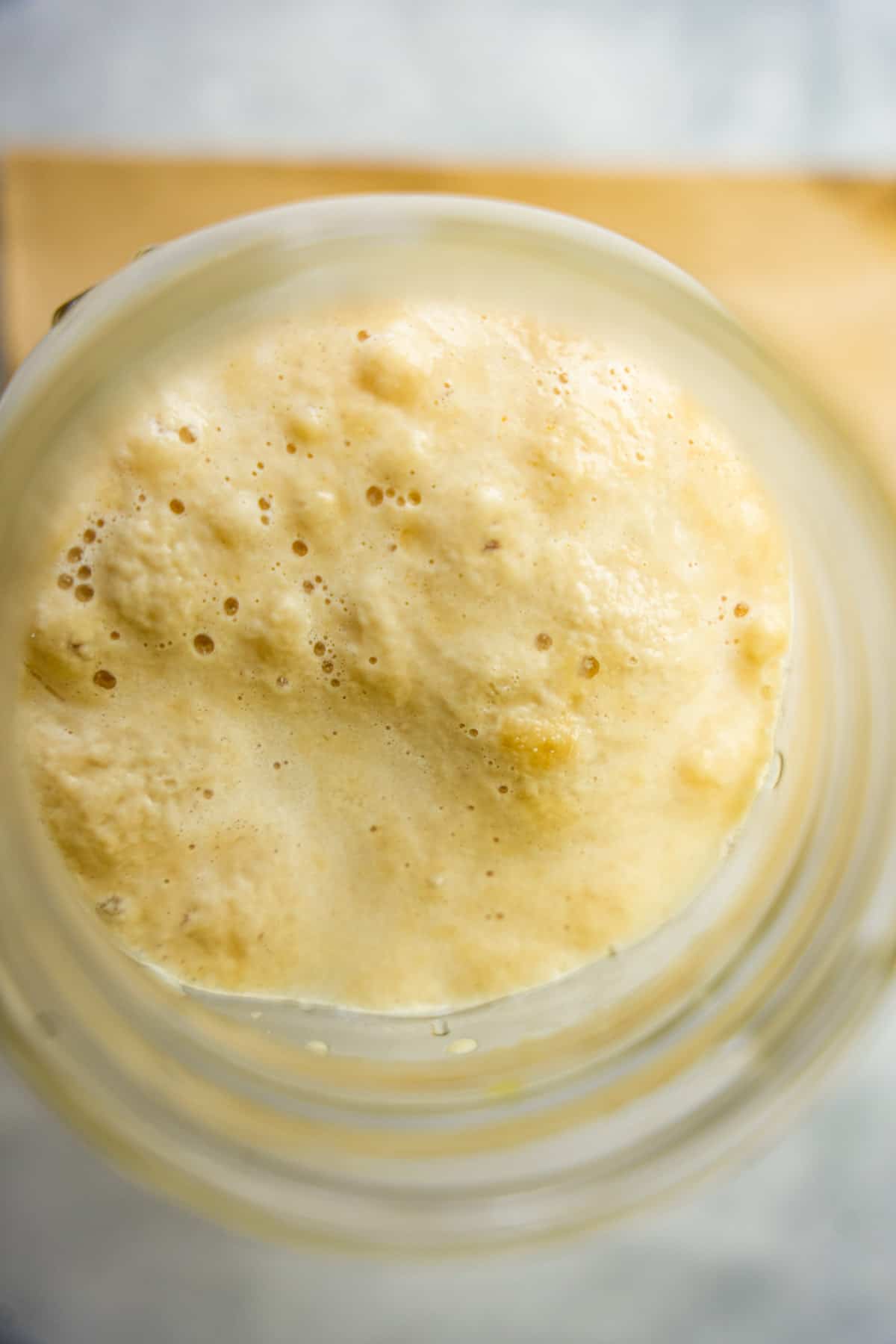
Step 1
Activate the yeast by mixing warm water, yeast, and sugar in a bowl. Set aside to bloom.
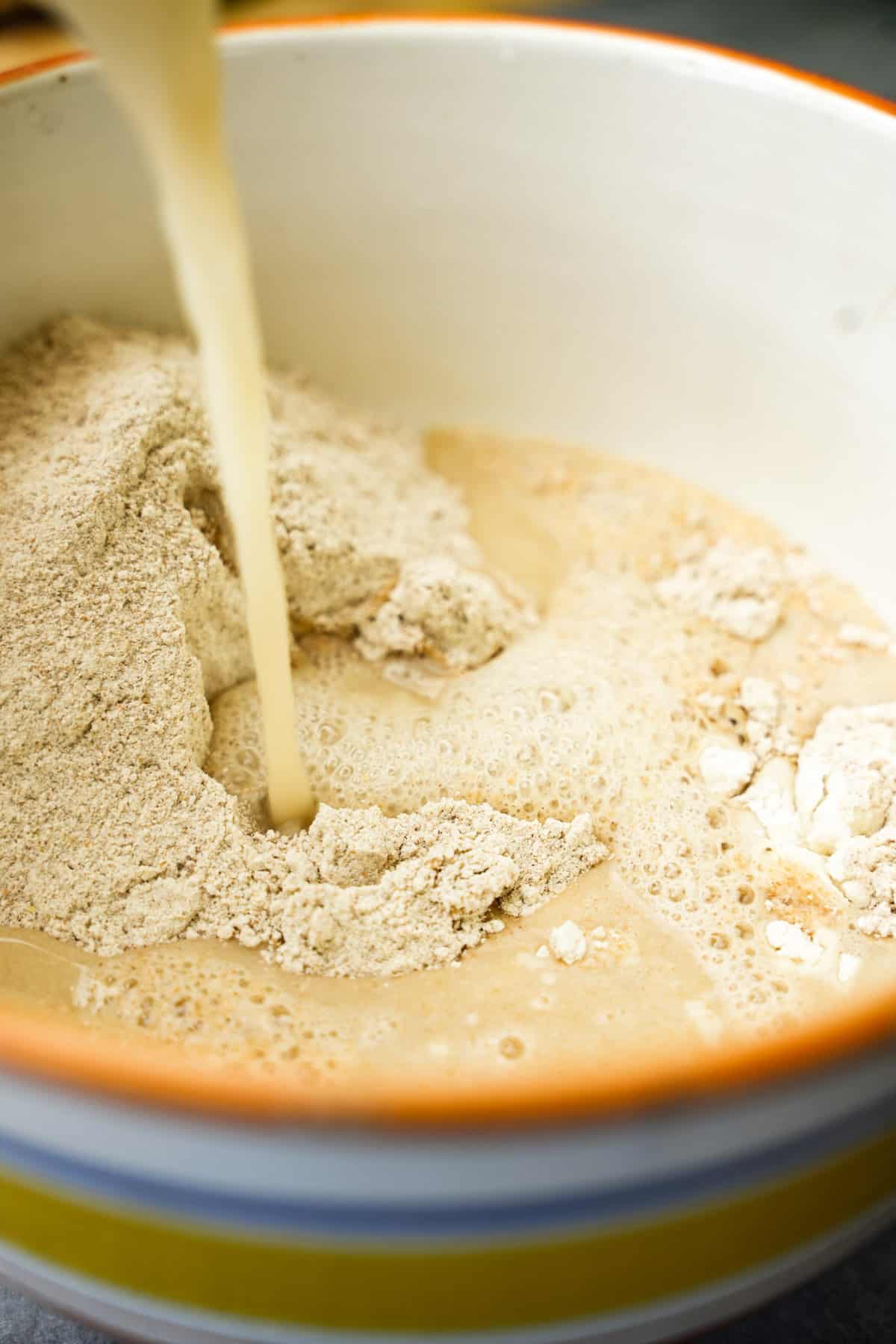
Step 2
In a large mixing bowl, mix the whole wheat flour, all-purpose flour, and salt. Pour in the yeast mixture and olive oil. Knead on a lightly oiled work surface for 4-5 minutes until soft and smooth. Alternatively, you can knead it for three minutes on low speed in a stand mixer using a dough hook attachment.
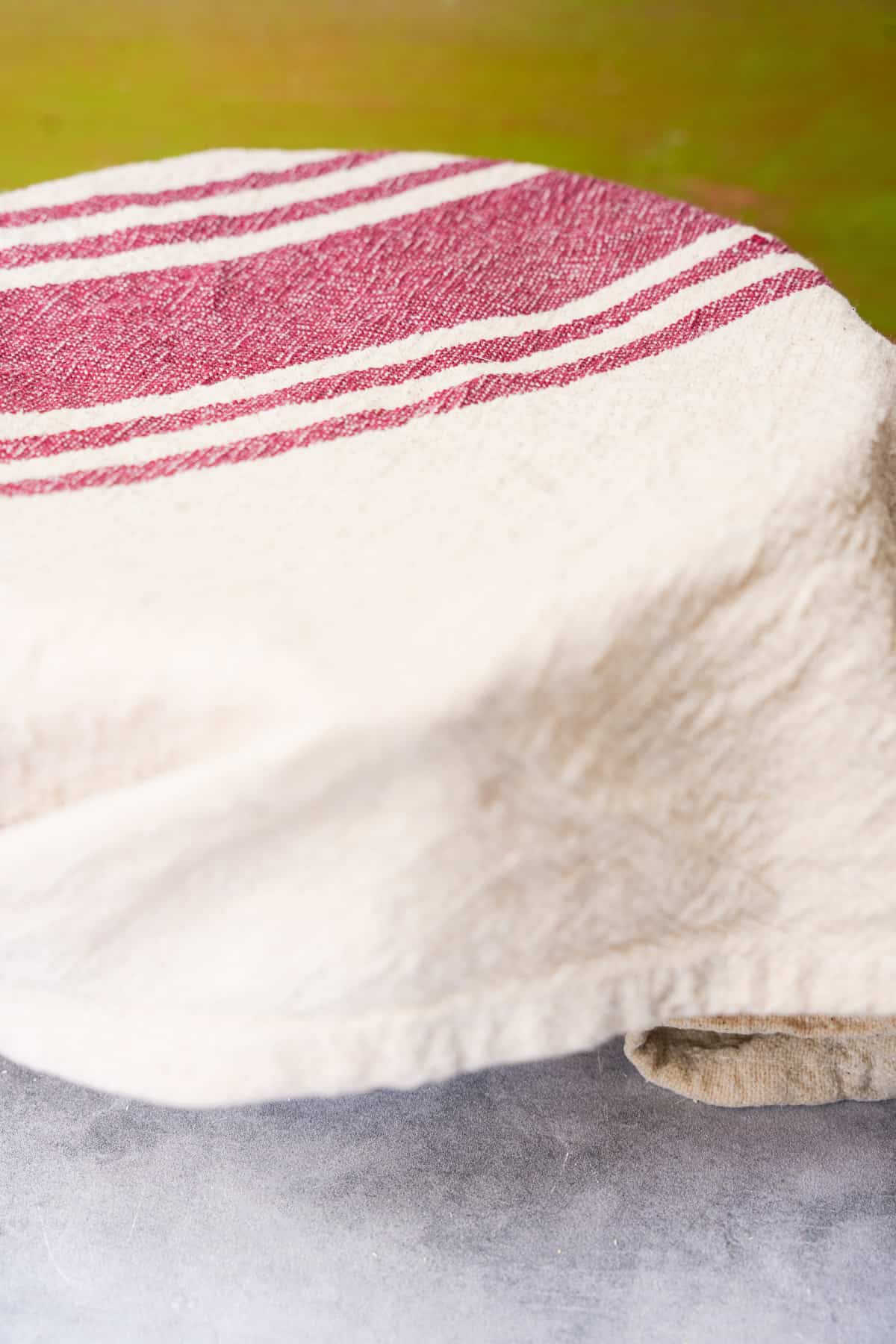
Step 3
Cover the dough and let it rise for one hour.
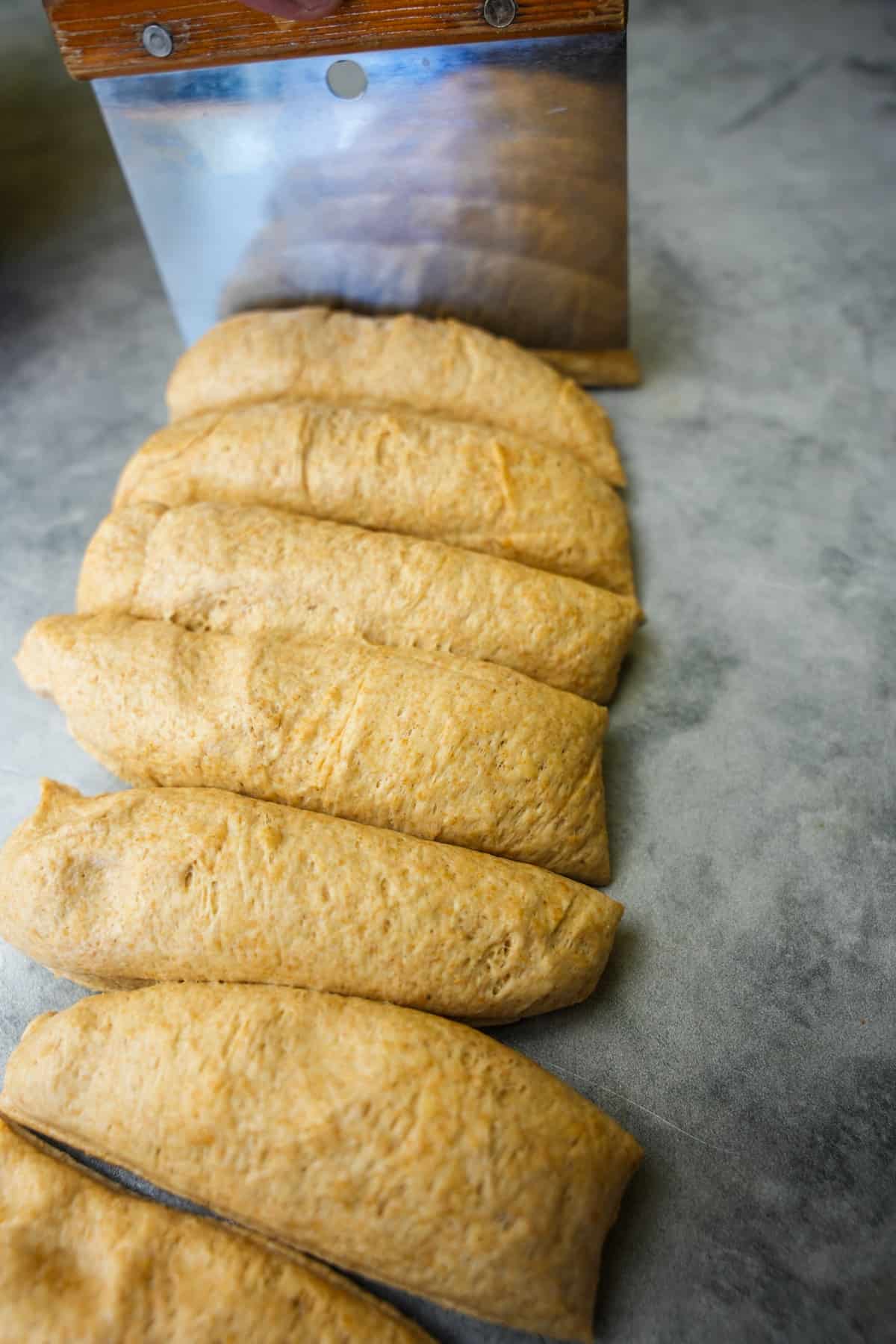
Step 4
Divide the dough into 8 pieces and shape them into balls.
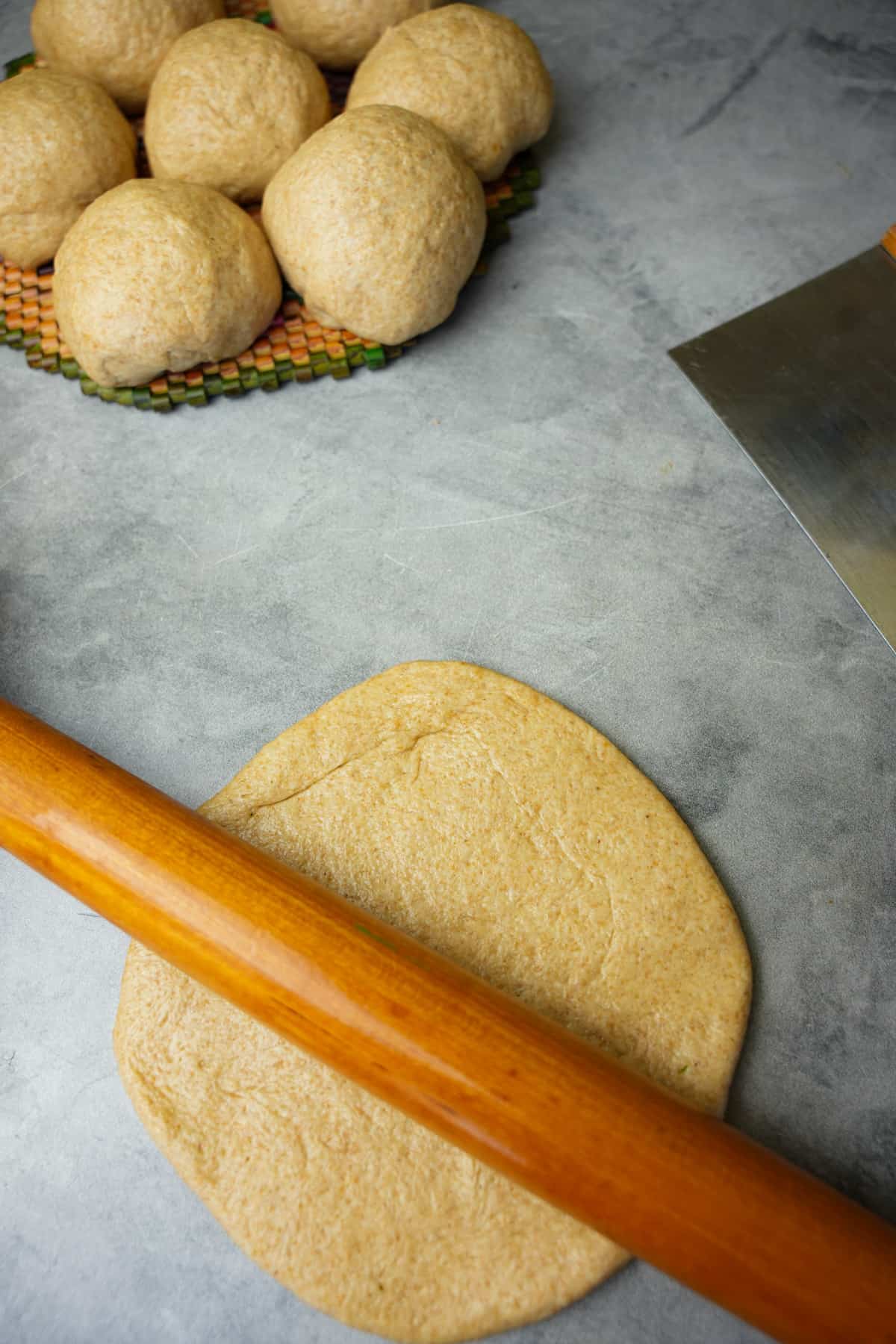
Step 5
Roll out each ball on a lightly oiled or floured surface to form round, flatbread shapes.
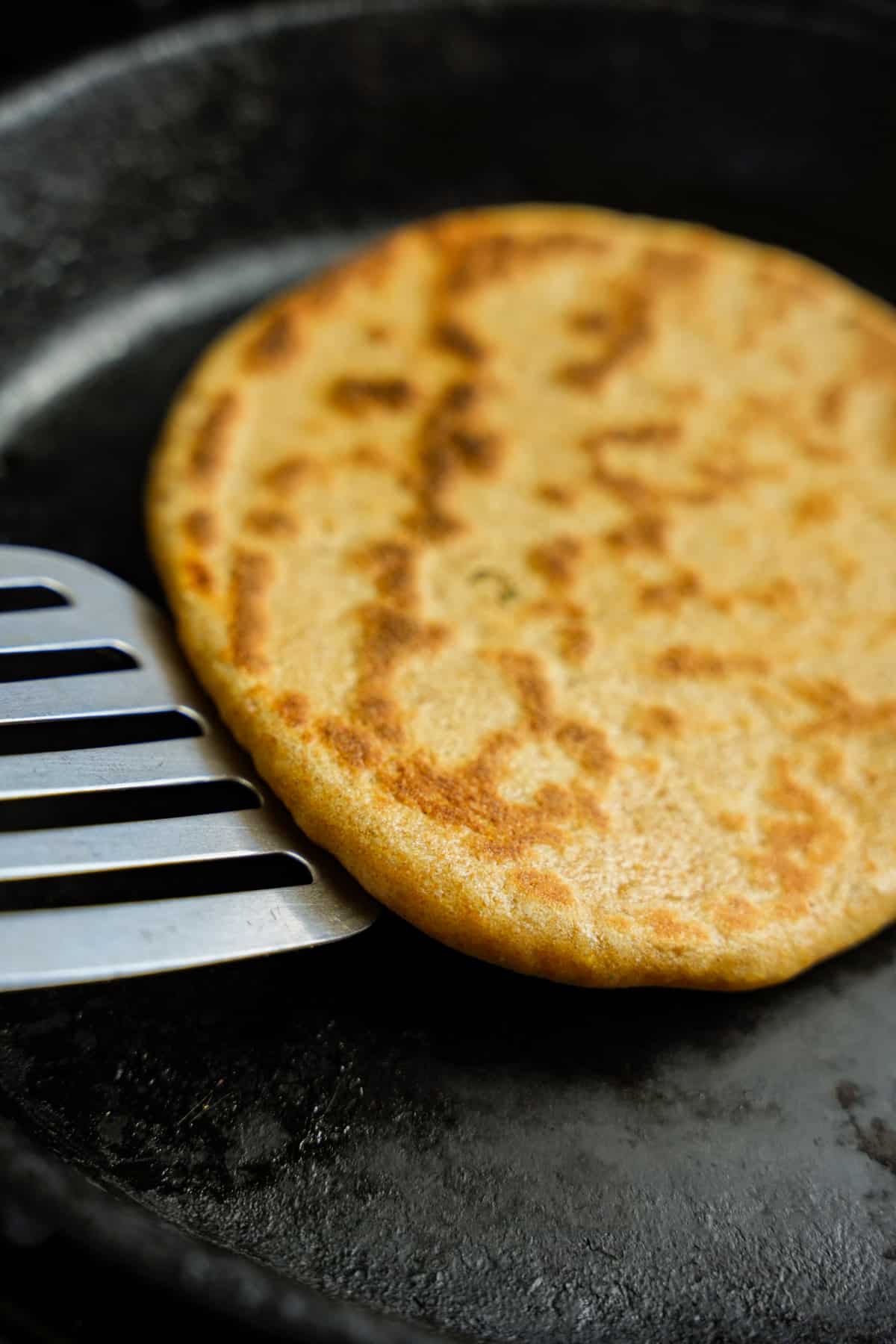
Step 6
Cook each flatbread on a low to low-medium heat in a pan or iron skillet. Flip when it starts to puff up.
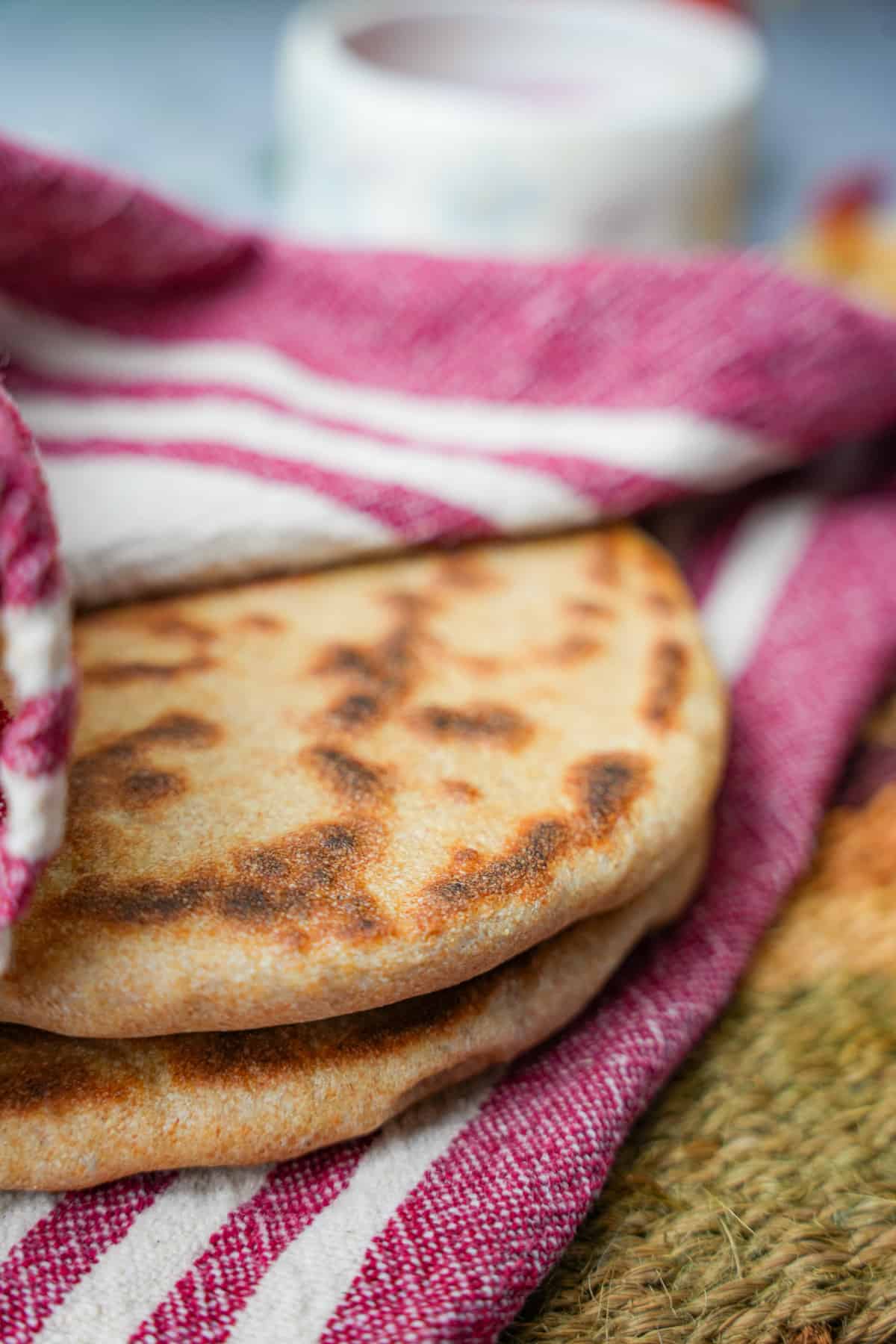
Step 7
Cover the cooked pita breads with a towel to keep them warm and maintain their softness.
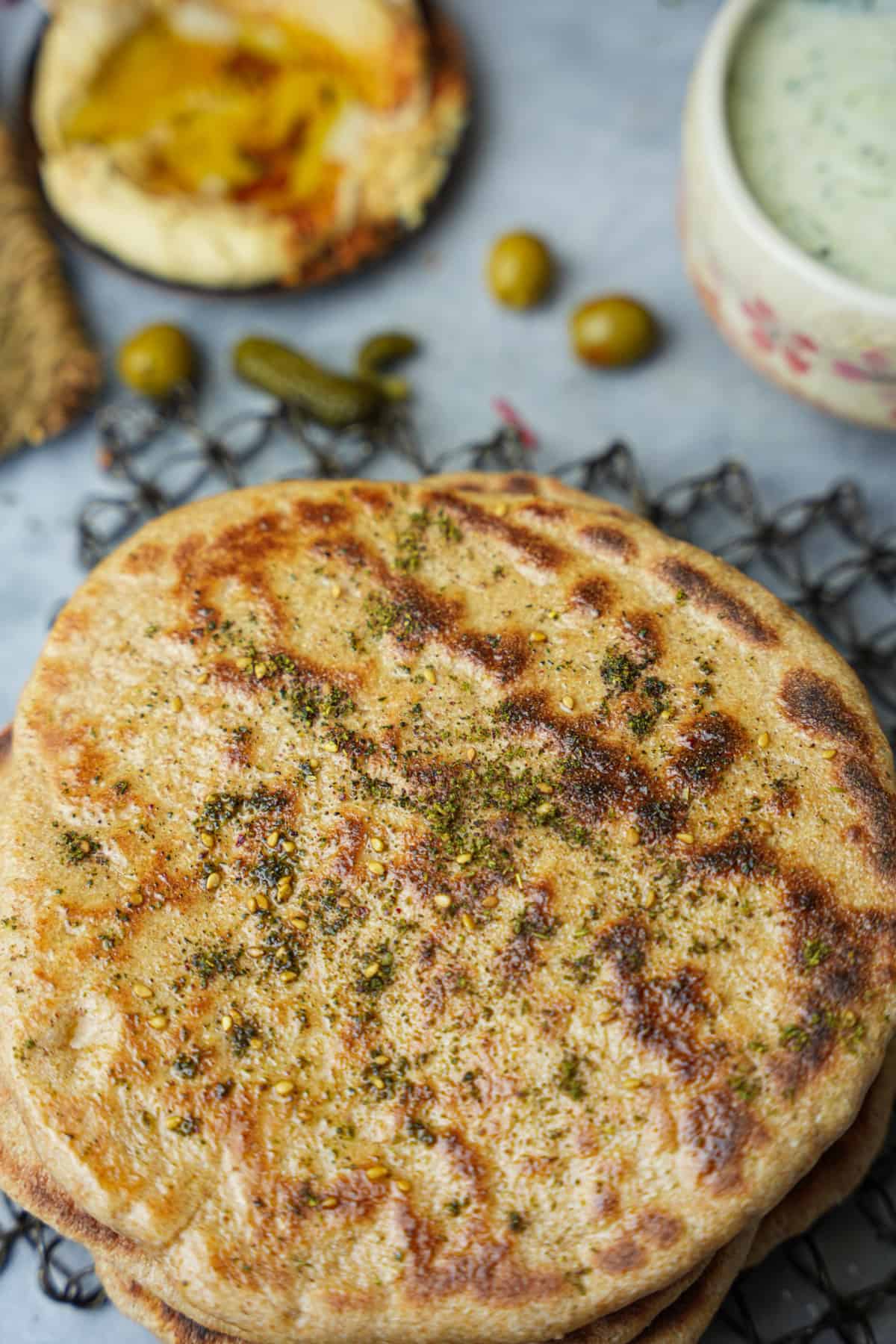
Step 8
Optionally, brush the hot pita with olive oil and dust with homemade baharat or za'atar.
💡Serving Ideas
Stop using stale packaged pitas that you found in a musky old dungeon. Homemade fluffy pita is going to bring everything you serve with it to the next level!
It's just about as glorious to scoop up the Yemeni-style green hot sauce zhoug with as it is for eating creamy, smoky mutabal all over!
Definitely use this kuboos as a flat bread for my acili ezme, serve it alongside some of my easy-to-make tabouleh, eat a giant mountain of my vegan butter chicken and/ or ridge gourd curry with it, serve it with a hot bowl of dal tadka, or red lentil dahl.
Make it to have alongside Turkish classics like Barbunya Pilaki, Bulgur Pilavi (Turkish Cracked Wheat Pilaf), Turkish lentil soup, or Cig kofte. It also compliments Moroccan dishes (alllllmost as much as Msemen does) such as Loubia, or the classic Ramadan fast-breaker harira (tomato soup with chickpeas and lentils)
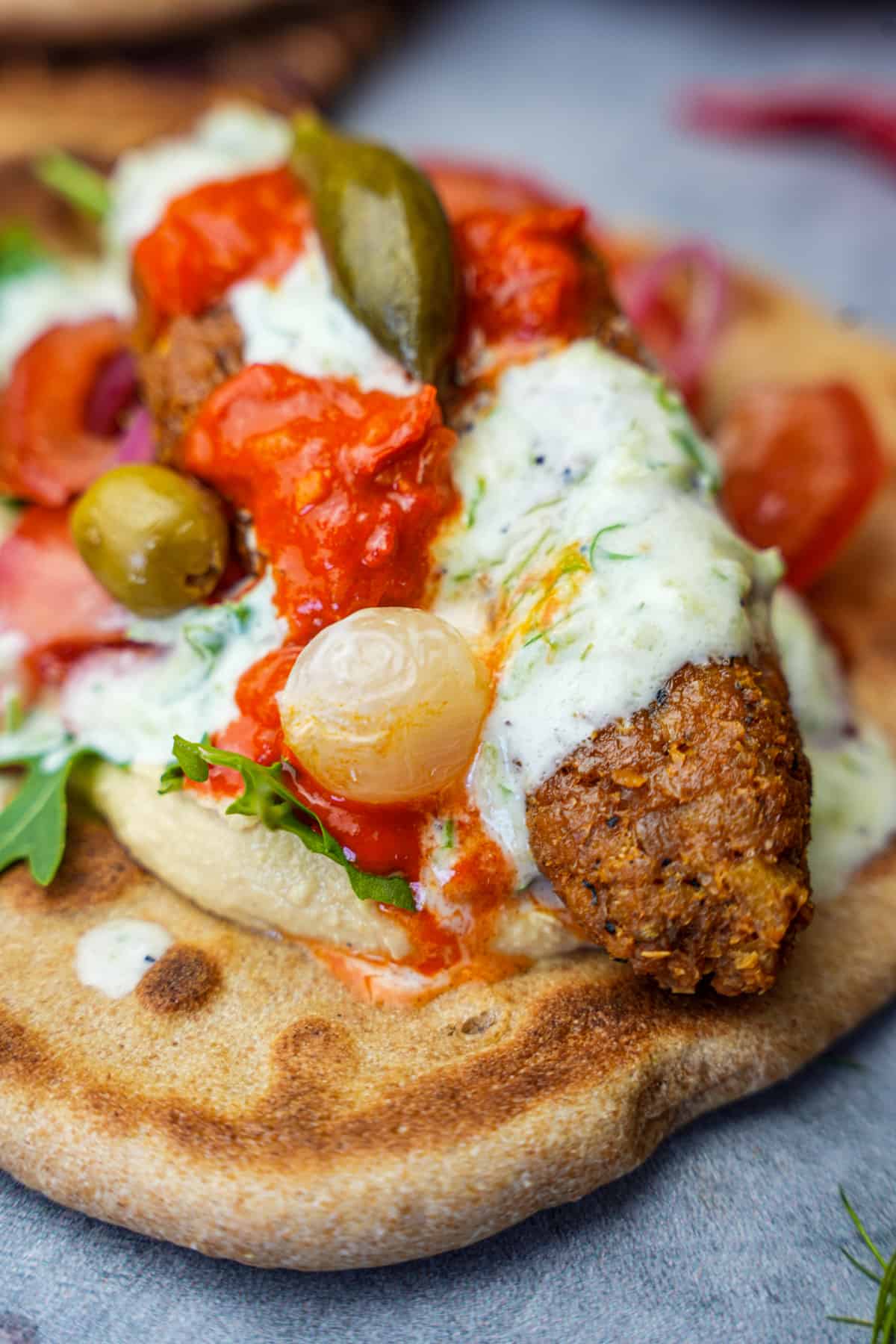
🤷♀️Recipe FAQs
To bake kuboos (Arabic pita bread) in an oven, preheat your oven to 450°F (230°C) and place a baking sheet, pizza steel, or pizza stone on the center rack. Once your kuboos dough has been rolled out, brush the top of each dough round with a bit of olive oil, and place them on the preheated baking sheet or stone. You may do this by hand if you are careful, or launch it onto the stone using a pizza peel. Bake for 2-3 minutes until the bread puffs up and develops a pocket.
Once the bread has puffed up, flip it over using tongs or a spatula and continue baking for an additional 1-2 minutes until the bread is fully cooked and slightly browned.
Remove the bread from the oven and transfer it to a plate, covering it with a kitchen towel to keep it warm until ready to serve. Note that baking time may vary depending on the size of your oven, and the proximity of the oven rack to the oven’s heat source, so keep an eye on it to prevent burning.
To ensure that your bread fully puffs and develops a pocket, there are a few things you can do:
Make sure your oven or stovetop is hot enough: For oven-baked pita, preheat your oven to a high temperature (around 450-500°F or 230-260°C) and make sure it has reached its temperature before baking the pita. For stovetop-cooked pita, heat your skillet or griddle over medium-high heat until it's hot.
Roll out the dough evenly: Try to roll the dough out to a consistent thickness so that it cooks evenly and doesn't have any thick spots that might prevent it from puffing.
Don't add too much flour: When rolling out the dough, try not to add too much flour, as this can prevent the pita from puffing up properly. If the dough is too sticky, you can lightly flour your work surface or hands, but don't overdo it.
Cook it for the right amount of time: Cook the pita until it has puffed up and started to develop a golden-brown color, which should take around 2-3 minutes per side. If the pita hasn't puffed up by the time it's cooked through, it might need a little more time on the heat.
Cover them after cooking: Once you've cooked the kuboos bread, cover them with a clean kitchen towel or wrap them in foil to help trap the steam and keep them soft and pliable. This will also help the pockets to form as the steam pushes the bread open.
The best way to store freshly baked pita bread is in an airtight container or plastic bag at room temperature for up to 2-3 days.
❄️Freezing
IIf you want to store them for longer, you can freeze them for up to three months. To freeze, separate each pita bread with parchment or wax paper and place them in a freezer-safe container or bag. Press the air out of the bag, seal it well, and label the bag with the date.
⏲️Saving the dough to make later
To save the dough, you can refrigerate it for up to 24 hours. After shaping the dough into balls, cover them tightly with plastic wrap and place them in the refrigerator. When you're ready to bake, let the dough sit at room temperature for 30 minutes before rolling out and cooking. This will help the dough to come to room temperature and rise a bit more.
If you want to save the dough for longer than 24 hours, you can freeze it. Shape the dough into balls, wrap each one tightly in plastic wrap, and place them in a freezer-safe container or bag. When you're ready to use the dough, let it thaw in the refrigerator overnight, then bring it to room temperature and allow it to rise before rolling out and cooking.
Whole wheat flour contains enzymes and enzyme inhibitors that can affect the fermentation process. Enzymes are natural proteins that can break down starches and other nutrients in the dough, while enzyme inhibitors can slow down or inhibit these enzyme activities. The presence of these enzymes and inhibitors in whole wheat positively (in my opinion) impacts the fermentation process and results in a more robust flavor profile.
Whole wheat flour contains more natural oils, bran, and germ compared to all-purpose flour, which can provide additional nutrients and flavors for the yeast to ferment. These extra nutrients can affect the yeast's fermentation process and produce a much more complex flavor than pita made with all-purpose flour.
All-purpose flour has a lower protein content than whole wheat flour, resulting in a softer and more tender texture in the final bread. Whole wheat flour, on the other hand, has a higher protein content and can create a denser texture. All-purpose flour generally has a finer texture than whole wheat flour, allowing for better gluten development and gas retention during fermentation.
By incorporating some all-purpose flour in the flour mix, you can achieve a balance between the desirable characteristics of whole wheat flour and the softer texture of all-purpose flour, resulting in the perfect flavor, and texture in the finished bread.
I have tested different ratios of flours, and know you will love the result of following my recipe!
To create a more typical Greek-style pita (which is even better for serving my vegan kofta with tzatziki on), you need to dimple the dough before baking. Here's how:
✅ Substitute the whole wheat flour in the recipe for all-purpose (so you are only using white flour, and not a mix).
✅After rolling out the dough into the desired oval or round shape, use your fingertips to make small indentations all over the surface of the dough. These indentations will help the pita bread to puff up.
✅Be sure not to press too hard, as you don't want to poke holes in the dough. The indentations should be shallow and evenly spaced.
✅Once you've dimpled the dough, allow it to proof for 30 minutes on a covered tray.
✅Add a teaspoon of olive oil to your pan, and when you are cooking the pitas, cover the pan so that they cook partially by steaming in the pan.
❤️ My faves to serve with homemade kuboos:
Say Hi on Social! 👋
Follow me on Instagram & Facebook for more recipes.
❤️Love this recipe? It helps me out greatly if you leave a 5-star 🌟🌟🌟🌟🌟rating in the recipe card below and maybe even leave me a lovey-dovey comment too!
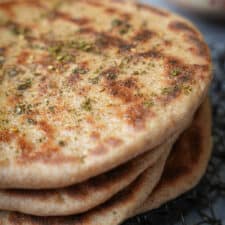
Perfect fluffy Kuboos (Arabic pita bread)
Ingredients
- 2 cups whole wheat flour
- 1 ¼ cup all-purpose flour
- 1 cup warm water
- 2 ½ teaspoons active dry yeast
- 2 teaspoons brown sugar or granulated sugar
- ½ teaspoon salt
- ¼ cup Extra Virgin Olive Oil
- Optional: extra virgin olive oil to brush the fresh pitas and za’atar to garnish
Instructions
Step 1: Forming the Dough
- In a small bowl, mix warm water (between 105°F and 115°F, or 40°C and 46°C), yeast, and brown sugar. Set aside for 5 minutes until the yeast becomes active and foamy.
- In a large bowl (or bowl of a stand mixer with a dough hook if you are not kneading by hand), add whole wheat flour, all-purpose flour, and salt. Pour the proofed yeast mixture into the bowl and mix gently. Make sure to use a rubber spatula to scrape out all of the yeast residue and settled sugar.
- Mix by hand for about two minutes to form a smooth, soft dough.
- Add the olive oil to the flour mixture and start kneading for 4 minutes until the dough is soft, and smooth. If you are using a stand mixer, this should take 3 minutes on low speed.
- Cover the bowl with a moistened kitchen towel, and set it aside for an hour at room temperature, allowing it to double in size.
Step 2: Dividing and forming the pitas
- Once the dough has doubled in size, remove it from the bowl and transfer it onto a clean work surface.
- Divide the dough into 8 even portions using a knife. Shape each piece into a ball shape with lightly oiled hands.
- Take each ball and gently roll it out using a rolling pin until it becomes a round flatbread 6-7 inches (15-17 cm.) in diameter.
- Cooking Tip: You can adjust the thickness of the flatbread to your preference by rolling it out thinner or thicker. If you make it on the thicker side, it may take a little longer to cook.
Step 3: Cooking the dough to make Kuboos
- Heat a frying pan or cast iron skillet over medium heat.
- Working one at a time, place each round of flatbread dough into the dry pan and let it heat for 3 minutes on each side until it starts to puff up.
- Flip the flatbread using a spatula and let it heat for another 30 seconds or until it forms a pocket and puffs up.
- As you cook additional bread, cover the cooked kuboos with a kitchen towel to help maintain their warmth.
- Brush the cooked kuboos with a little olive oil for added flavor before serving.
Notes

Enter your email & I'll send it to your inbox. Plus, get great new recipes from me every week!
By submitting this form, you consent to receive emails from Cinnamon Snail.

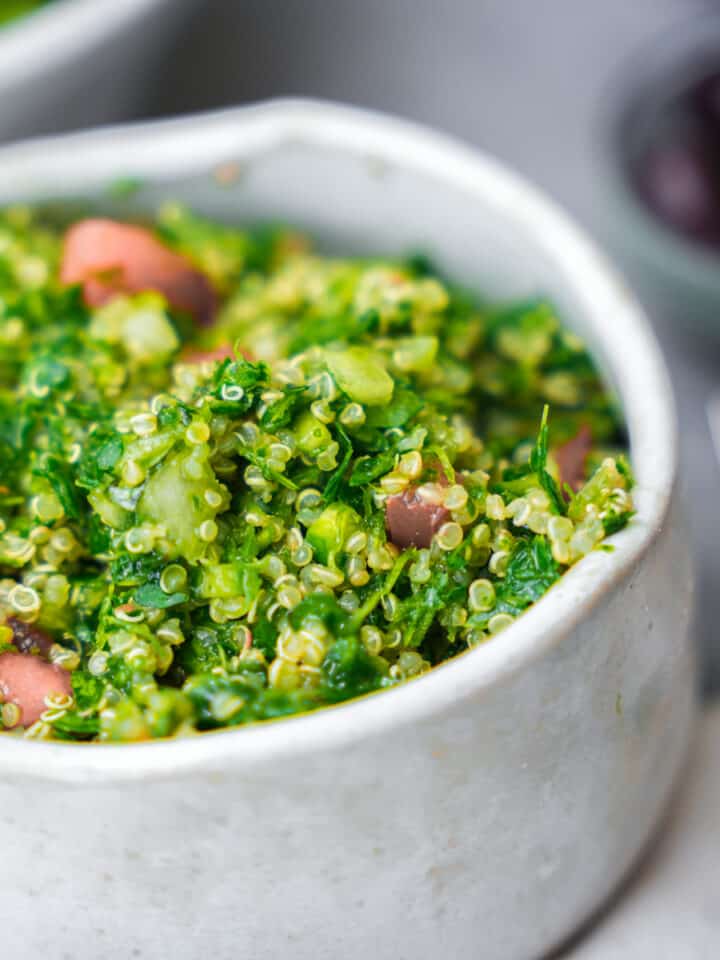

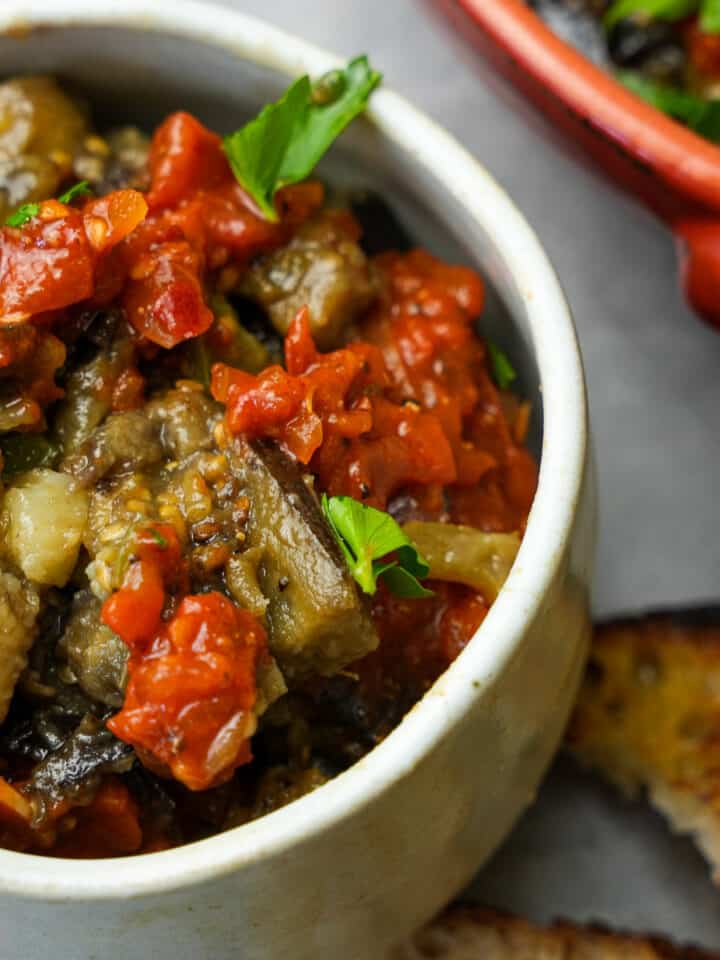
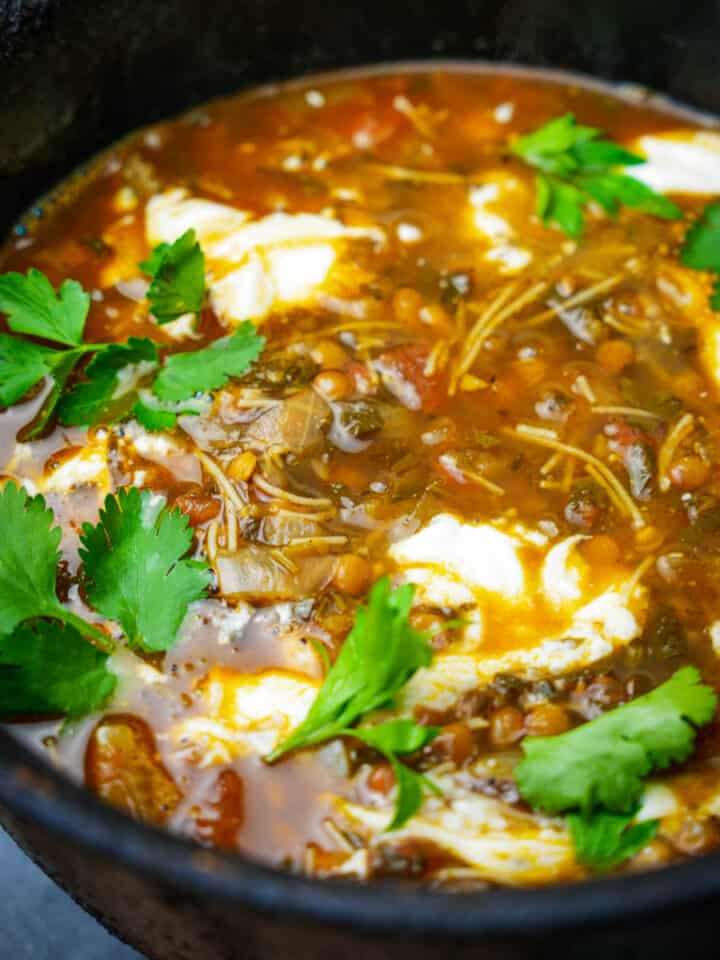






Meg says
These are so so good. Bullet proof recipe. My plans changed between making the dough and cutting it into 8 so I bundled it into the fridge. Turned out just fine. Really really fine!
Thanks Chef Adam.
Heather says
I will not buy store pita again after making these delicious Pita from Adam's recipe. They pita came out so fluffy and delicious DH was seriously impressed when we cut them and there was the pocket inside. I froze half the recipe for lunch later in the week the overnight defrost worked perfectly. I need to have some of these in the freezer ready to go for any lunch Thank you Adam
Roxanne says
These were delicious. They were flavorful and tender. The pitas weren't hard to make. They don't have the pocket like some pita breads do. They will need to be folded and eaten like a taco shell.
Adam Sobel says
Glad you liked 'em. To ensure your pita bread forms a pocket, make sure the dough is evenly rolled out to about a quarter inch thick and let it rest before cooking. Heat your oven or skillet very hot—around 475 degrees Fahrenheit for the oven, or until the skillet is smoking slightly. Cook the pita quickly on each side until it puffs up, trapping steam inside that forms the pocket.
HG says
WOW! After making these, I can't believe I've been buying store bought ones for so long. So much better when homemade. Fresh and warm right out of the pan.
Cheryl says
Very easy to make and so delicious hot off the pan, I served them with the tabouli and the kofta with tzatziki sauce, an amazing meal!